|

by
Jiri Mruzek
Are the World's Biggest Building Blocks Prehistoric?
In 27 BC, the Roman Emperor Augustus supposedly took the unfathomable
decision to build in the middle of nowhere the grandest and mightiest temple
of antiquity, the Temple of Jupiter, whose platform, and big courtyard are
retained by three walls containing twenty-seven limestone blocks, unequaled
in size anywhere in the world, as they all weigh in excess of 300 metric
tons. Three of the blocks, however, weigh more than 800 tons each. This
block trio is world-renowned as the "Trilithon".
 If we think within the official academic framework of history,
Augustus had
no obvious reasons for selecting Baalbek as the temple's building site.
Supposedly, Baalbek was just a small city on a trading route to Damascus
through the Bekaa valley in Lebanese mountains, about sixty kilometers from
the Mediterranean coast (34º lat., 36º long.) It was of no special religious
significance, apart from being in the centre of a burial region, in the midst of thousands of rock cut
tombs. If we think within the official academic framework of history,
Augustus had
no obvious reasons for selecting Baalbek as the temple's building site.
Supposedly, Baalbek was just a small city on a trading route to Damascus
through the Bekaa valley in Lebanese mountains, about sixty kilometers from
the Mediterranean coast (34º lat., 36º long.) It was of no special religious
significance, apart from being in the centre of a burial region, in the midst of thousands of rock cut
tombs.
But, lavishing great architecture on Baalbek then seems totally out of
character for the undeniably selfish Rome, which had at the very same time
been stealing historic treasures from other countries, such as the obelisks
from Egypt. It makes more sense that Baalbek had something no other place
could offer, not even the city of Rome, the heart of the empire. This
something may also be the reason why so many people wished to be buried
there. Indeed, it has been noted that the blocks in the retaining wall
of the Baalbek temple site clearly look a lot more eroded than
the bona fide Roman ruins of the Temple of Jupiter, as well as those of the
other two Roman temples also on the site. Therefore, the heavily eroded
blocks should be much older.
|

Bonfils, ca. 1870. Negative inscribed "468. Mur Cyclopeen a Balbek."
Albumen. Unmounted.
11 x 9 inches.
© 1996 Middle East Section.
Joseph Regenstein Library.
The University of
Chicago |
This fact naturally gives rise to a different scenario: At
Baalbek Rome had
found a fabulous ready made foundation, a mighty platform to add a suitably
majestic structure to, stamping the Roman eagle upon the whole for the
perception of future generations.
Material Evidence
The much greater erosion of the big Baalbek blocks qualifies as material
proof of their much greater age. The issue really seems rather simple. This
is how the stone looks when it is almost like new after having
been recently sanded. However, sanding did not get rid of the deep pits,
signs of either considerable previous erosion, or the product of drilling,
if not both. |
Circumstantial Evidence
One also finds plenty of circumstantial evidence undermining the official
version of Trilithon's origins:
a) Absence of Baalbek records.
Above all, Rome records no claim to the incredible retaining wall.
b) Presence of other records of actual Roman transport capabilities.
Elsewhere in the Roman empire, just a little over 300 metric tons seemed to
be the limit for the transport of big blocks, achievable only with the
greatest difficulty. Transport of the 323 ton Laterano obelisk to Rome
spanned the reigns of three emperors. Clearly, the record setting engineers
from Baalbek, had they existed, could have also managed the task of
transporting the relatively light Lateran Obelisk.
The fact that they were nowhere to be found, no matter, how crucial the
task, indicates that they simply did not exist.
c) Baalbek was an important holy place.
The Ptolemys conferred the title of Heliopolis upon
Baalbek. Therefore, like
the other Heliopolis (Sun City) under Ptolemys' domain in
Egypt, it had to
be an ancient holy place, it must have had some notable architecture, and
the two places had to have some connection. I suggest it was the titanic
blocks that instilled awe in everybody. In Phoenician times,
Baalbek had
supposedly been a religious centre devoted to Baal. Local Arab legends place
the cyclopean walls (the Baalbek Terrace) into the time of Cain and
Abel.
d) Roman and Megalithic styles of building.
Orthodox scholars of today scoff at all suggestions that Romans had not
brought the great blocks to the temple site, despite the fact that building
with megalithic blocks was not at all in the Roman style, and was no longer
practiced in those days. Romans knew and used concrete. The Colosseum still
standing in Rome is a good example of a classic Roman concrete structure.
|
The sad truth is that regarding the
Trilithon, some scholars have mental
blocks its own size. Admissions that blocks weighing over a 1000 metric tons
were quarried and transported in prehistoric times would invite
uncomfortable questions on what technology had made it all possible.
Regardless of such touchy issues, I have several personal observations,
which support dating of Baalbek's megalithic walls to the megalithic era.
Have a look at this nice northwestern view of the wall (right image) as it was circa 1870.
|
 |
The wall has two distinctly contrasting parts:
-
One forms the bulk of the wall, five layers of considerably eroded blocks.
Several such blocks also survive in the sixth layer. Sizes of these blocks
vary from big to unbelievably big, the largest building blocks anywhere.
-
The second part is a later Arab addition. Its blocks differ by being:
The Arabs had a fortress here. It was devastated by wars and finally by a
major earthquake several centuries ago. The Romans must have left the old
sacred enclosure walls as they were, and concentrated on building the
temples. They had no need for defensive walls like the Arabs.
|
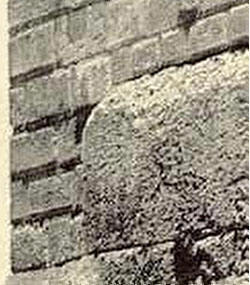
The top corner of the
northern block of the Trilithon is well rounded by erosion, and
human abrasion. One of the newer, small blocks rests directly on
this eroded, round spot. So, when it was lain into this position,
the damage was much like it is today.
It is evident that one block is a lot older than the others, as the
position of the newer blocks marks the extent of erosion in the
older blocks at the time |
If the big blocks were to be
Roman, then the newer Arab blocks would mark
the erosion of the older Roman blocks as it was after the first six or
seven-hundred years. But, how could this erosion be a lot greater than the
subsequent erosion of both the old and the new blocks in twice as much time?
In the details below, we can see that whoever had added the smaller blocks
(presumably also limestone, and coming from the same quarry, the nearest one
to the temple), had made adjustments for erosion in the old ruin, which are
visible as steps, or notches in the elsewhere straight line of the newer
blocks. The eroded blocks seem to have been hewn flat on top to facilitate
the laying of additional blocks.
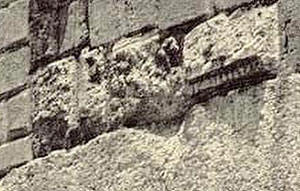
Of the four blocks atop the eroded blocks, each is at a different horizontal
level |
|
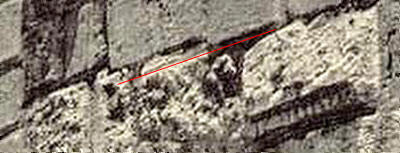 |
Time to Draw the Line
A horizontal line was cut into the older block. It seems to continue the
bottom line of the neighboring newer block quite exactly. The red line you
see is there to show this fact.
I believe that the cut
line had marked the top portion of the older block, which was to be
cut away, so that the newer blocks could be set level. Thankfully,
the plan was not carried out for some reason. |
Consequently, we
have a clear clue to what had happened here.
Because the line in the eroded block survives about as well as the newer
blocks, the two materials must be similarly durable.
It then follows that by the apparent rate of aging, the heavily eroded
blocks should be at least several millenia older than the newer blocks.
Ergo, the older part of the wall cannot be Roman.
|
Hadjar el Gouble (the Stone of the South) 1,170 metric tons
In a quarry about half a mile away from the Trilithon is an even bigger
block It measures 69 x 16 x 13 feet, ten inches, and weighs about 1,170
metric tons.
There is a belief, the block was slated for the retaining wall,
but was later found to be too big. Thus, it was abandoned in the quarry
while still joined to the bedrock at one end. |
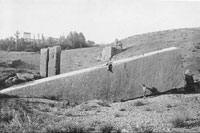 |
The important question is, was it younger, or was it older than the three
Trilithon blocks? It seems that it had to be made later than the
Trilithon.
If it was made first, and then deemed to be too big, it would have still
been utilized, rather than quarrying a new block, the Romans would have
simply whittled the big block down to a more manageable size. We would not
see it in the quarry today.
On the other hand, despite their brilliant ability to move about burdens as
unprecedented as the Trilithon, the unknown architects lost their nerve at
the very end, the big block looming almost ready. There was no attempt to
move the practically finished block. This just does not behoove the solid
Roman engineers, especially the creme de la creme entrusted with the task by
the Emperor himself. Why did they leave behind a monument to their
engineering limits and human weaknesses, and by extrapolation - Roman
emperor's limitations? Again, this would be very un-Roman of them, and even
more so in view of what the same engineers saw at Aswan. It is a fact that
the big block still in a Baalbek quarry seems to weigh about the same as the
famous abandoned obelisk at Aswan, Egypt. Here, the question begs itself if
this really is by chance.
How could the two biggest ever blocks of quarried stone coincide in weight,
despite being made in different eras, by different techniques, and abandoned
for different reasons? Not likely, is it?
This thread gets funnier, when we learn that the fifty-four enormous columns
for the Jupiter's temple actually came from Aswan! There the Roman engineers
could not have missed witnessing the abandoned 1,170 ton obelisk, which the
Egyptians had obviously intended to move, prior to discovering that it was
cracked, a fatal flaw.
Did the obelisk somehow inspire Romans to quarry a block of the same weight
(albeit not proportion) at Baalbek, and then abandon it, when almost
complete, mimicking the Egyptians ad absurdum, every inch of the way? Monkey
see, monkey do? Is this not insane?
Another theory holds that work on the block stopped, when Rome suddenly
became Christian, and stopped all construction on the site. That is of
course impossible, because the retaining wall with the big blocks was long
complete by then, and where else would the big block go, other then the
retaining wall? So, none of the explanations makes sense
Then there is that utter lack of documentation for these stunning exploits,
which should have been proudly noted by Roman historians, politicians, and
so on. It's a little like if American history books skipped the fact that
America went to the Moon. Meanwhile, local legends ascribe the stones to the
time of Genesis. The big blocks were part of a fortress built there by
Cain.
So, did Romans move the Trilithon blocks? Absolutely not! Romans had no
desire to move such weights, because they knew just as well as we do that
they could not move even substantially smaller blocks. History supports our
notion with solid evidence from the same time period.
When Augustus, emperor of Rome had conquered the region in 27 BC, he ordered
that the massive obelisk towering above others at the Karnak temple in Egypt
be brought to Rome, but the effort was aborted, when the trophy proved too
heavy. Sources give varying estimates of its weight, from 323 tons to 455
tons.
The discrepancy must stem from the fact that the original obelisk was 36
meters long, and had weighed 455 tons. Now that it is 4 meters shorter at
the base, it must be correspondingly lighter, and because obelisks are
always considerably thicker at the base than higher up, the loss of a
hundred tons would be realistic. So, the discrepancy is self-explanatory.
It seems to suggest a reason to why some 300 years later, Emperor
Constantine I (reigned A.D. 306-337) had succeeded where Augustus had
failed, namely, in taking the obelisk out of Egypt. But, in the process, the
pedestal and a large part of its base were destroyed. Well, since we are
talking about the otherwise indestructible Aswan granite, we have to deem
the obliteration of the thickest, strongest part of the obelisk deliberate.
Unable as they were to move the whole obelisk, the Romans had taken only as
much as they could carry. After all, Constantine's workers had similar
troubles with the obelisk of Tuthmoses III now standing in
Istanbul. Here is
a quote I found at Andrew Finkel's site:
"The decision to import the structure was taken by
Constantine himself. Rome
had at a dozen obelisks. His city, Constantinople or the "New Rome" had to
have at least one. The Byzantines succeeded in fetching the monument from
Deir el Bahri near Thebes, although in a sawn-off form. The original shaft
was probably a great deal longer. Yet having brought it to the harbor on
the Sea of Marmara side of the city, no one could figure out for an entire
century how to get it up the hill"
At the same time the big 323 ton Lateran obelisk from
Karnak was still in
Alexandria, remaining there until after Constantine's death. His son,
Constantius II [reigned A.D. 337-340] had then taken it to Rome instead.
However, it did not get to Rome's Circus Maximus until A.D. 357, seventeen
years after the death of Constantius II. Finishing the centuries old project
took almost fifty years...
Knowing all these facts then bears heavily on our judgment of what the
Roman could, or could not do at Baalbek.
a) Roman engineers had failed to even budge the 455 ton
Thutmoses' obelisk
at Karnak for emperor Augustus.
b) But, allegedly, the same Roman engineers had successfully transported the
three Trilithon blocks weighing twice as much, plus, twenty-four more blocks
weighing pretty well as much, i.e., 300 - 400 tons, all of which we see in
the enclosure wall of the Baalbek temple terrace.
Moreover, the transport of the
Trilithon blocks would have had been
incredibly rapid, because the retaining walls should be in place prior to
the construction of the temple itself, as logic would seem to dictate
Unable to move the 455 ton Karnak obelisk, Augustus took two other obelisks
from the Sun Temple in Heliopolis, instead. It was the first transport of
obelisks to Rome. The obelisks are now in the Piazza del Popolo (235 tons),
and the Piazza di Montecitorio (230 tons). Funny, 235 + 230 = 465. So,
Augustus got his 455 tons, plus change, but it was in two parts. These are
solid indications of the then Roman capacity in moving heavy objects.
|
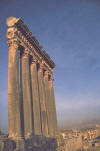 |
Why did Romans pick the remote
Baalbek? Did they do it for practical
reasons, utilizing older structures, and perhaps plentiful building
materials already onsite?
Even the fifty-four enormous yet typically
Roman columns from Aswan granite,
which had once surrounded the courtyard, of which six are still standing
(image left),
may be pre-Roman, but later recarved in the Roman style. Despite being as
magnificent as they are, the spectacular and unprecedented construction
achievements at Baalbek were not heralded to the world as its own by the
proud and glory hungry Rome. Why not? |
Making such a claim would have been impossible, if the world already knew
about the awesome Baalbek ruins, of course. If Roman and other writers had
failed to mention the great Baalbek blocks, they were in
amazing sync with
the modern day's attitude.
|
 If we think within the official academic framework of history,
Augustus had
no obvious reasons for selecting Baalbek as the temple's building site.
Supposedly, Baalbek was just a small city on a trading route to Damascus
through the Bekaa valley in Lebanese mountains, about sixty kilometers from
the Mediterranean coast (34º lat., 36º long.) It was of no special religious
significance, apart from being in the centre of a burial region, in the midst of thousands of rock cut
tombs.
If we think within the official academic framework of history,
Augustus had
no obvious reasons for selecting Baalbek as the temple's building site.
Supposedly, Baalbek was just a small city on a trading route to Damascus
through the Bekaa valley in Lebanese mountains, about sixty kilometers from
the Mediterranean coast (34º lat., 36º long.) It was of no special religious
significance, apart from being in the centre of a burial region, in the midst of thousands of rock cut
tombs.






